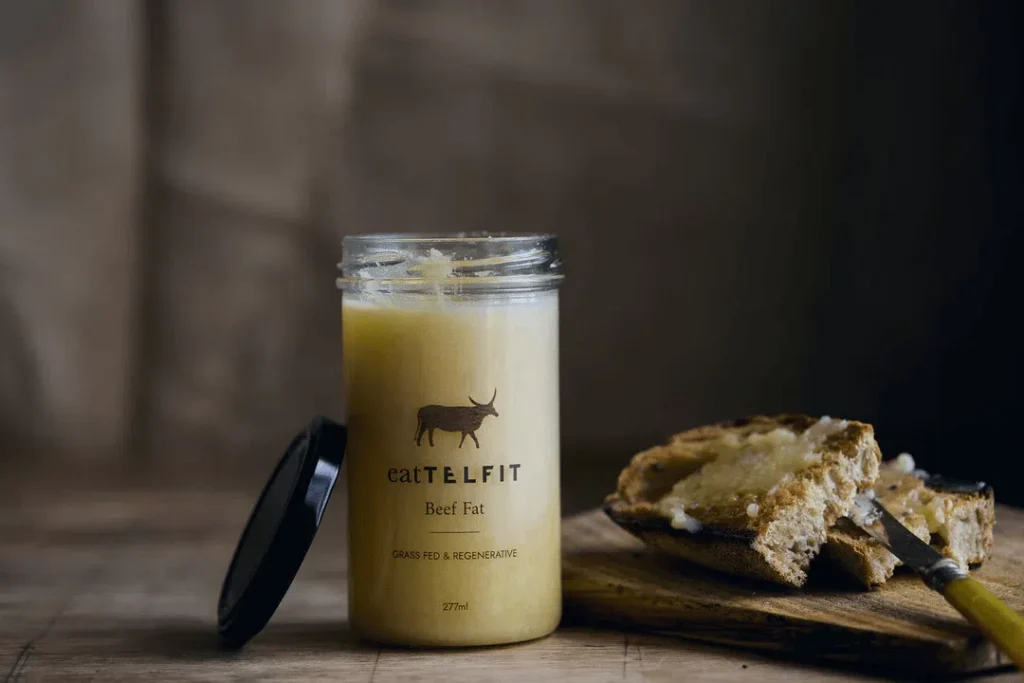If you’ve been wondering, “is beef tallow healthy?” you’re not alone. The old-school cooking fat has found new life in home kitchens thanks to its flavor, high heat performance, and nostalgic appeal. But health-wise, where does it really stand compared to butter, olive oil, or seed oils? Here’s a clear, balanced look at what beef tallow is, how it behaves in cooking, what the science says about saturated fat and heart health, and smart ways to use it without overdoing it.
What Is Beef Tallow?

How It’s Made
Beef tallow is simply rendered beef fat, usually from suet (the dense fat around the kidneys) or trim. Rendering involves gently heating chopped fat until it melts, then straining out solids. The result is a clean, shelf-stable cooking fat that’s solid at room temperature and melts into a clear oil when heated. Traditional kitchens prized tallow for frying, roasting, and even pastry dough thanks to its neutral, beefy richness and stability.
Fatty Acid and Nutrient Profile
Tallow’s fatty acids are predominantly saturated and monounsaturated, with very little polyunsaturated fat. Typical ranges: roughly 45–55% saturated fat, 40–50% monounsaturated (largely oleic acid, the same heart-healthy fat abundant in olive oil), and about 2–4% polyunsaturated. You’ll also find trace amounts of fat-soluble vitamins (A, D, E, K) and naturally occurring ruminant trans fats (like vaccenic acid and CLA) in small quantities. While grass-fed tallow can have slightly more omega-3s and CLA, the absolute amounts are still modest, think flavor and cooking properties first, not micronutrient supplementation.
Potential Health Benefits
Smoke Point, Cooking Stability, and Oxidation
For high-heat searing or frying, you want a fat that doesn’t break down easily. Tallow’s smoke point typically falls around 375–420°F (190–215°C), and its low polyunsaturated content makes it relatively resistant to oxidation compared with many seed oils. That means fewer heat-induced breakdown products when you cook at high temperatures. Practically, you get crispier potatoes, better sears, and a fat that holds up well for roasting. Still, no fat is invincible, avoid overheating to the point of smoking, and don’t reuse frying fat repeatedly, which increases oxidation and off-flavors.
Satiety and Blood Sugar Support
Fat slows gastric emptying and can help you feel fuller longer. Used thoughtfully, tallow can increase meal satisfaction and may blunt blood sugar spikes when it replaces refined carbs. For example, roasting vegetables in a small amount of tallow often makes them more filling and tasty, so you’re less tempted to overdo dessert. The caveat: satiety gains only help if portions stay reasonable: calorie-dense fats can tip you into surplus quickly.
Health Considerations and Risks
Saturated Fat, LDL Cholesterol, and Heart Health
Here’s the crux of the “is beef tallow healthy” debate. Tallow is high in saturated fat, and saturated fat intake can raise LDL (“bad”) cholesterol in many people. Elevated LDL is causally linked to atherosclerotic cardiovascular disease. Major heart-health organizations still recommend limiting saturated fat, often under 10% of daily calories (and 5–6% for those with high LDL or heart disease). Replacing some saturated fat with unsaturated fats, especially polyunsaturated, from sources like olive oil, nuts, and fatty fish is associated with improved lipid profiles and lower CVD risk.
That doesn’t mean you can never cook with tallow. It means dose and overall pattern matter. If your baseline diet is rich in fiber, vegetables, legumes, and unsaturated fats, occasional tallow for high-heat cooking can fit. If your LDL is elevated or you have familial hypercholesterolemia, be more conservative and coordinate with your clinician.
Calorie Density and Individual Response
Like all fats, tallow is calorie-dense, about 120 calories per tablespoon. It’s easy to overshoot your needs with a generous pour or pan-fry habit. Also note individual variability: some people are “hyper-responders” whose LDL rises sharply with higher saturated fat, especially on low-carb diets. If you’re experimenting with tallow (or ketogenic eating), consider periodic lipid testing to see how your body responds.
How Beef Tallow Compares to Other Fats
Tallow vs Butter, Ghee, and Lard
- Butter: Similar flavor appeal, but butter contains milk solids and water: those burn faster. Tallow is cleaner for high heat. Butter and tallow have comparable saturated fat: butter brings a bit more short-chain fats, but for heart health they’re in the same neighborhood.
- Ghee: Clarified butter with milk solids removed. Ghee and tallow both handle heat well. Ghee’s aroma is nuttier: tallow’s is more neutral-beefy. Saturated fat remains high in both.
- Lard: Typically has a little more monounsaturated fat and more polyunsaturated fat than tallow (varies by pig diet). It’s softer at room temp and slightly less saturated overall, but still not a low-sat-fat option.
Bottom line: among animal fats, tallow is a heat-stable choice, but none of these are “heart-healthy” in the way olive oil is.
Tallow vs Olive, Avocado, and Seed Oils
- Extra-virgin olive oil (EVOO): Rich in monounsaturated fat and polyphenols: consistently linked with better cardiometabolic outcomes. Smoke point is moderate, but its antioxidant content also contributes to real-world cooking stability. For everyday sautéing and dressings, EVOO is hard to beat.
- Avocado oil: High in monounsaturated fat with a high smoke point, good for higher-heat cooking. Quality can vary: choose reputable brands with clear harvest/bottling info.
- Seed oils (canola, sunflower, soybean): Higher in polyunsaturated fats, which can improve LDL when replacing saturated fat. They’re more prone to oxidation at high heat, especially with repeated frying, but routine home cooking within normal temperatures is generally fine. If your goal is the most heat-stable option for searing, tallow has an edge: if your goal is cardioprotective fat intake overall, olive oil leads.
Quality, Sourcing, and Storage
Grass-Fed vs Grain-Fed
Grass-fed tallow can have slightly more omega-3 and CLA and often a cleaner, beefier flavor. The differences are real but small nutritionally: you won’t meet omega-3 needs with tallow. Choose grass-fed if you prefer the taste, farming practices, or trace differences, but prioritize overall dietary pattern first.
Rendering, Additives, and Safe Storage
Look for pure rendered beef tallow with no additives. Avoid partially hydrogenated products (industrial trans fats), which are largely phased out in the U.S. anyway. Store tallow in an airtight container away from light and heat. It’s relatively shelf-stable: a cool pantry works for months, and the fridge extends quality further. Always use clean utensils to avoid contamination, and discard if you notice off smells, discoloration, or rancidity.
Smart Ways to Use Tallow in Your Diet
Portion Sizes and Best Uses
Think of tallow as your high-heat specialist and flavor booster, not your default everyday fat. Practical ideas:
- Roasted potatoes or root veggies: 1–2 teaspoons per serving for crisp edges.
- Cast-iron searing: a thin film for steaks, chops, or mushrooms.
- Frying occasionally: great for shallow-frying when you want serious crunch.
- Savory baking: swap part of butter/shortening for tallow in pie crusts or biscuits for flakiness.
Keep portions modest, about 1 teaspoon to 1 tablespoon depending on the dish, and balance the rest of the meal with plants, lean protein, and unsaturated fats.
Who Should Be Cautious
You should be more careful with tallow if you:
- Have high LDL cholesterol, familial hypercholesterolemia, or a history of heart disease.
- Are on a medically supervised low-fat diet or have conditions affected by fat digestion (e.g., pancreatitis: follow your clinician’s guidance).
- Notice a strong LDL rise when you increase saturated fat (get labs, don’t guess). In these cases, lean more on olive oil, nuts, seeds, and fish, and reserve tallow for rare, purposeful uses.
Conclusion
So, is beef tallow healthy? It’s a stable, flavorful cooking fat that excels at high heat, but it’s also rich in saturated fat, so context and portion control are everything. Use it strategically for searing and roasting, keep an eye on your lipids, and base most of your fat intake on unsaturated sources like olive oil, avocado, nuts, and fish. That way, you get the best of both worlds: culinary performance when you need it and a diet that supports long-term heart health.
Frequently Asked Questions
Is beef tallow healthy?
Beef tallow is heat-stable and great for searing, but it’s high in saturated fat, which can raise LDL cholesterol. In the context of a diet rich in vegetables, fiber, and unsaturated fats, occasional tallow can fit. Keep portions small and lean on olive oil, nuts, and fish most days.
Does beef tallow raise cholesterol?
Tallow’s saturated fat can increase LDL (“bad”) cholesterol in many people, and some are hyper-responders who see larger jumps, especially on low-carb diets. If you add more tallow, monitor your lipids with periodic bloodwork. Those with high LDL or heart disease should limit saturated fat and prioritize unsaturated oils.
Is beef tallow healthy compared with olive oil for everyday cooking?
For health outcomes, extra-virgin olive oil wins: it’s rich in monounsaturated fat and polyphenols and is linked to better cardiometabolic risk. Beef tallow is more heat-stable for intense searing, but higher in saturated fat. Use tallow sparingly for high heat; choose olive oil for daily sautés and dressings.
What is the smoke point of beef tallow and the best way to use it?
Beef tallow typically smokes around 375–420°F (190–215°C). Its low polyunsaturated content makes it relatively resistant to oxidation, ideal for searing, roasting, and occasional shallow-frying. Avoid overheating to visible smoke and don’t repeatedly reuse frying fat; both increase oxidation, off-flavors, and potential irritants.
Is beef tallow healthy for people with lactose intolerance or dairy-free diets?
Yes. Pure beef tallow contains no lactose or milk proteins, so it’s generally suitable for dairy-free diets. As with anyone else, the healthfulness depends on dose and context: keep saturated fat within recommended limits and base most fats on unsaturated sources like olive oil, avocado, nuts, and fish.
How much beef tallow is okay to eat in a day?
There’s no set limit for tallow, but major guidelines suggest keeping saturated fat under 10% of calories (about 22 g on a 2,000-calorie diet). One tablespoon of tallow has roughly 120 calories and about 6–7 g saturated fat. Practical use: 1 teaspoon to 1 tablespoon per dish.

